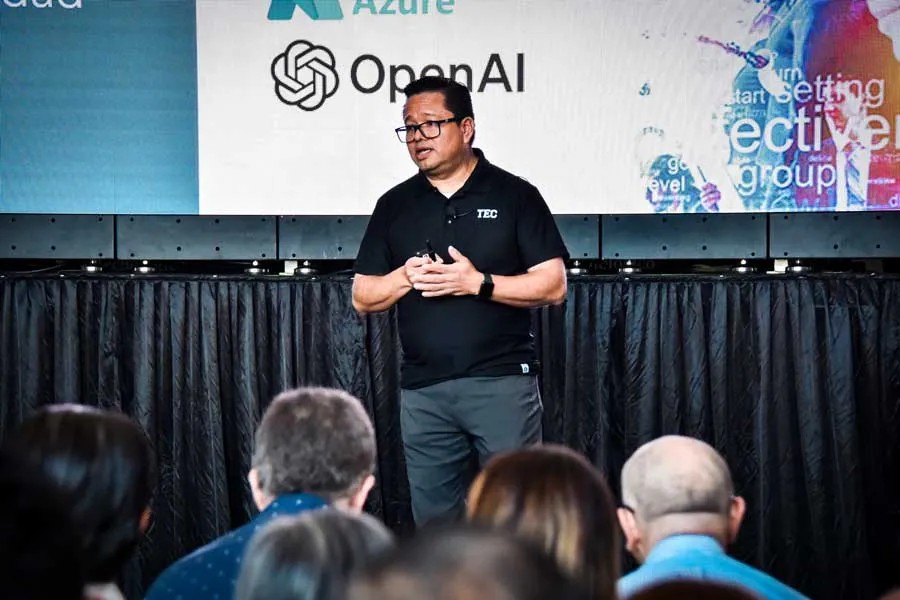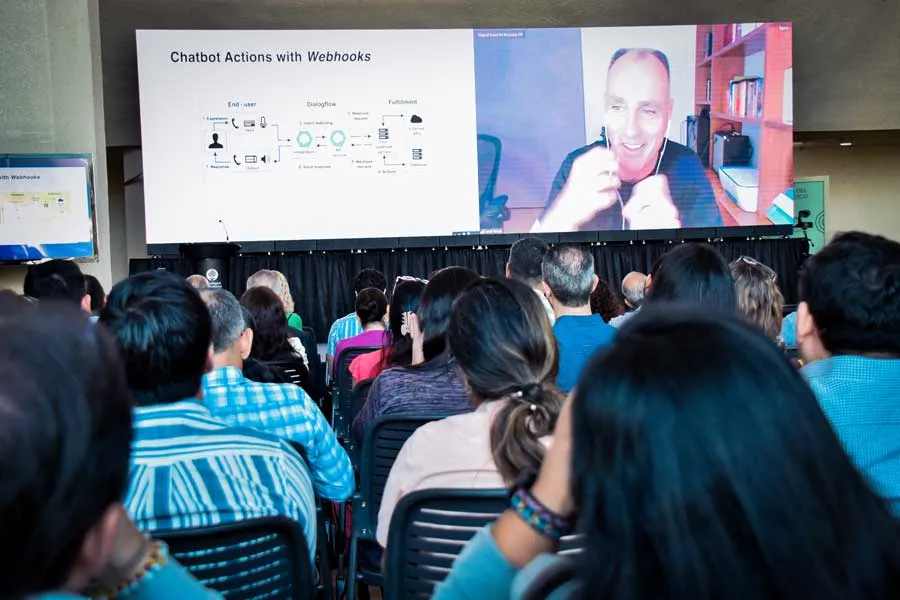Tec de Monterrey has unveiled Tecgpt, its own generative artificial intelligence model, which can already be used by some of the institution’s staff in beta mode.
“Tec de Monterrey has always been part of cutting-edge projects; it’s in the institution’s heart and soul. Today, we’re the first in Mexico and Latin America to have our own generative artificial intelligence model.”
These were the words of Carles Abarca, Vice President of Digital Transformation at the Tec, on Artificial Intelligence Day, an event to present advances in the use of the world’s generative AI and the Tec’s own internal tool.
Abarca highlighted that, just like the first Internet connection in Latin America, TECgpt represents a historic step forward for the institution in terms of information technology. At the moment, it can be used in a trial mode to request information about some of the institution’s internal procedures.
The event also included talks and discussions between experts on these technologies to learn about their impact and areas of opportunity in organizations.

Tecgpt, a unique tool in Latin American universities
Although the Tec previously had Tecbot, an internal chatbot with predetermined responses, it is now beta testing Tecgpt, a conversational generative artificial intelligence model.
Manuel Terán, AI Platforms Manager at the Office of the Vice President of Digital Transformation at the Tec, was one of those responsible for presenting the tool, which can only be used by the first 500 users who sign up to test it for the moment.
This tool, powered by generative AI, allows users to obtain information through a chat interface about some of the institution’s procedures. It will also have the capacity to generate images and suggestions for social media posts.
Terán said that this initiative aims to offer the Tec community the functions of tools and application models in a safe technological ecosystem.
To achieve this, he said that they were using technology from the Microsoft Azure platform, mainly for privacy, as it offers enterprise security advantages; they were also implementing generative AI models such as GPT 3.5 Turbo, Ada-002, and DALL-E.
“The information is stored safely in this ecosystem; we can create components that can be consumed by our own community, which can be connected to our institutional databases in a safe way,” said the manager.
This platform has two modes: TECgpt-portal, available via a web browser; and TECgpt-api, which will integrate these technologies with facilitators already in use at the Tec to make them smarter, such as TECbot.
“We’re the first in Mexico and Latin America to have our own generative artificial intelligence model.” - Carles Abarca
Terán said that TECgpt’s structure includes four main areas: ChatGPT, image processing, TEC Chat, and the ability to create a certain number of specific-use models.
Among the models already available is one that offers the same ChatGPT smart query functionalities, as well as generating images based on a text description, generating social media posts, and summarizing texts.
“Our goal is to bring these AI skills to the entire Tec community,” said Luz Eunice Angeles, leader of the TECgpt initiative.
During the presentation of the platform, demonstrations were given on how it works and the ways in which professors and staff will be able to take advantage of the generative AI models that are integrated into TECgpt.
In the first stage, about 500 staff and faculty members will have access to this tool.

Sharing AI knowledge and applications
Other technologies were presented during AI Day, and there were talks on generative AI projects and their impact in organizations, as well as a panel of experts on the subject.
The demonstrations and topics shared included:
- Technological solutions with generative AI
Also presented was TecCHAT, a smart search tool for institutional knowledge that enables natural-language interaction and operates with its own and Tec-generated information.
Terán said that TecCHAT will provide support for institutional procedures such as consulting certificates, insurance, savings funds, and credentials.
“It’s not going to replace TECbot; it’s going to be a component for the Tec assistant that’s going to improve interaction,” he said.
Also shown were models based on generative AI, which are accelerators for generating solutions under a prompting scheme.
These models are focused on operational efficiency, the teaching-learning process, and research areas.
- Conversational AI assistants in organizations
Jordi Torras, AI and Machine Learning strategist at Imbenta, got attendees to think about the benefits and challenges of using chatbots and conversational AI-based virtual assistants in organizations.
During his presentation Large Language Model Disruption of the Traditional Chatbot and Virtual Assistant Market, he reviewed the evolution of classic assistants into those using Transformer-type neural networks, such as ChatGPT.
“Neural networks don’t analyze individual words, but tokens and numbers that are like vectors to group together terms for similar concepts; this allows us to be more efficient in areas such as sentiment analysis,” he said.
Using these technological assistants, organizations can provide dynamic, accurate, and fast responses to their users and interact in a more natural and personalized way, while also performing data analysis and automating complex tasks.

- Improving business with operations research and AI
Dr. Cipriano Santos, distinguished professor in Operations Research (OR) and AI, and Dr. Andrés Téllez, postdoctoral researcher on the OperAI research team, both from the Tec’s School of Engineering and Sciences, presented a project to optimize business processes.
Téllez and Santos, who is part of Tec’s Faculty of Excellence initiative, showed their work in Operations Artificial Intelligence (oper.ai), an initiative focused on automation and applied mathematics for business decision-making.
Their proposal consists of the development of tools based on OR and AI models that help develop optimization strategies through data analysis, demand prediction, and pricing and cost determination, among other aspects.
“Our dream is to use AI to help someone who knows nothing about mathematics to build their own models,” Dr. Santos said. “The idea is to help businesses distribute, ideate, and implement, to contribute to society.”
- Presenting an educational case study using OpenAI
Jorge Perez, Senior Data and AI Architect at Microsoft gave the talk From Feedback to Knowledge: Classifying Student Comments with OpenAI and Prompt Engineering.
The speaker introduced a real case, with data taken from student surveys, which demonstrated how to take advantage of the information obtained from them with the functions of the GPT model and prompt engineering.
Perez shared the programming code and keywords that were used in the prompt and entered into an Azure OpenAI model, showed the results, and made recommendations to the attendees about how to get better responses from the program.
“For an educational institution, GPT can provide immediate value in other cases such as having a virtual teacher to whom they can transfer their knowledge, or for professors to get an extra opinion or evaluation of a student text,” he said.

About AI Day
AI Day was a space for the Tec to present achievements and progress made in topics related to Artificial Intelligence.
Its motto was “Artificial Intelligence: Designing the Future from the Present” and it was held at the Luis Elizondo Auditorium on the Monterrey campus, as well as being broadcast through the Teams platform for the Tec’s staff.
This event’s objectives were to transform, inspire, and build a future where AI is a fundamental pillar in educational and research work, so that the Tec can be the undisputed leader in this field.
The tools introduced are part of the “Digital Route” in the Tec’s 2025 Strategic Plan, which proposes extraordinary digital experiences and facilitators integrated into all the plan’s projects.
READ ALSO:





